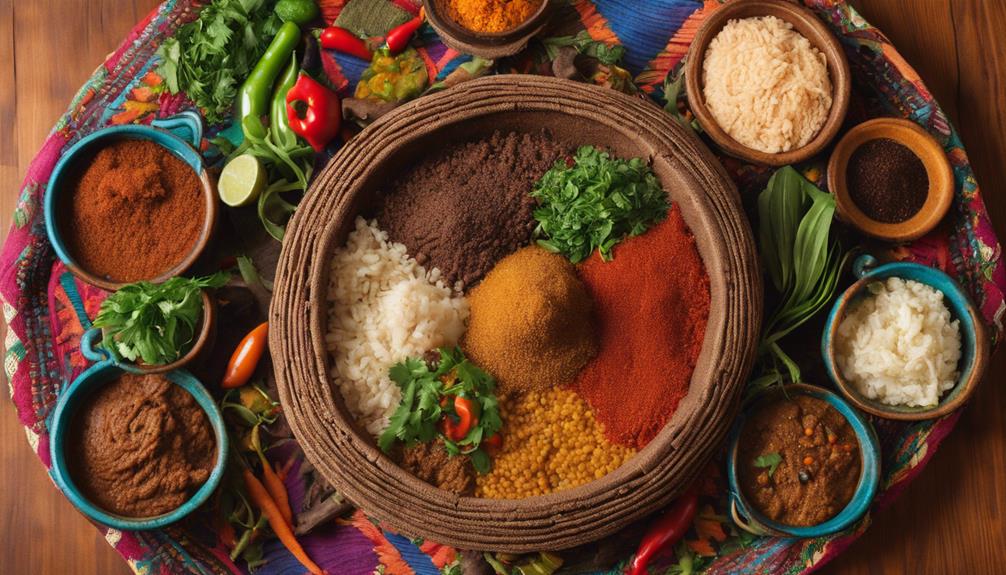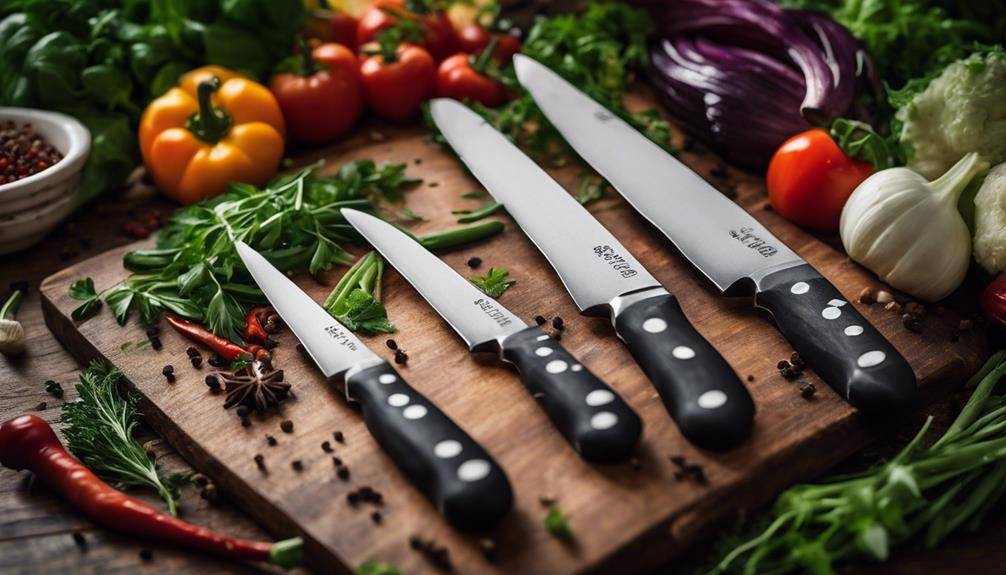Ethiopian Food And Its Unique Flavors

Ethiopian Food And Its Unique Flavors; Ethiopian food captivates you with its vibrant flavors and rich traditions. You’ll enjoy communal meals centered around injera, a tangy flatbread that doubles as your plate and utensil. Unique spices like berbere add depth to hearty stews known as wats. You can taste the essence of local agriculture, with nutrient-rich grains and fresh vegetables taking center stage. Vegetarian and vegan options abound, making it accessible to everyone. Each dish tells a story, reflecting Ethiopia’s diverse heritage and cultural significance. Discovering these unique flavors reveals a world of culinary delights waiting to be explored further.
Overview of Ethiopian Cuisine
Ethiopian cuisine is a vibrant tapestry of flavors and traditions that reflects the country’s rich cultural heritage. As you explore this culinary landscape, you’ll notice how Ethiopian history and cultural influences shape every dish. Dining rituals play a vital role, emphasizing community and shared experiences. Rather than individual plates, meals are often served on a large communal platter, allowing everyone to partake together, fostering connection and harmony.
Meal presentation is a feast for the eyes, as vibrant colors and intricate designs grace the injera, a sourdough flatbread that serves as both a plate and a utensil. Regional specialties abound, with each area boasting unique ingredients and flavors that celebrate local agriculture and food sustainability. You’ll find dishes prepared with spices like berbere that highlight the creativity and resourcefulness of Ethiopian cooks.
Culinary festivals throughout the year showcase this rich tradition, where you can taste various dishes and learn about the significance of food in Ethiopian culture. Festive occasions, like holidays and weddings, often feature elaborate spreads that bring families and friends together, reinforcing the importance of communal dining.
As you immerse yourself in Ethiopian cuisine, you’ll appreciate how each meal tells a story, blending history, culture, and a profound respect for local ingredients, all while inviting you to join in the celebration of flavors and traditions.
Key Ingredients in Ethiopian Dishes
When exploring Ethiopian dishes, you’ll quickly discover the importance of key ingredients that define their unique flavors. One of the most essential components is teff, a tiny, nutrient-rich grain that serves as the base for injera, the traditional flatbread. Injera isn’t just a side; it’s a part of the meal, absorbing the different flavors of the dishes served with it.
Another key ingredient is berbere, a spice blend that includes chili peppers, garlic, and a mix of other spices. It acts as one of the primary key flavoring agents in many stews, or wats, adding depth and a touch of heat. You’ll also encounter niter kibbeh, a clarified butter infused with spices, which brings a rich, aromatic flavor to various dishes, showcasing ancient cooking traditions that have been passed down through generations.
Legumes, such as lentils and chickpeas, are also staples in Ethiopian cuisine, providing protein and heartiness. Vegetables like cabbage, carrots, and potatoes often make their way into dishes, highlighting the country’s agricultural bounty.
Don’t forget about the fresh herbs, like cilantro and basil, which add a pop of freshness to many recipes. Each ingredient plays a significant role in creating the complex flavor profiles typical of Ethiopian food. By understanding these key ingredients, you’ll gain a deeper appreciation for the culinary artistry and history behind this vibrant cuisine.
The Role of Spices
Spices are the heartbeat of Ethiopian cuisine, elevating dishes with their vibrant flavors and aromas. You’ll find that the spice origins in Ethiopia trace back centuries, influenced by trade routes that brought diverse flavors from across the globe. This rich history has shaped unique spice blends like berbere and mitmita, which pack a punch in flavor intensity.
When you explore these blends, you’ll notice how they create a complex taste profile that’s vital to many dishes. The careful pairing of spices not only enhances the flavor but also reflects a deep cultural symbolism. Each blend tells a story, connecting you to Ethiopia’s culinary heritage.
Beyond flavor, spices also offer health benefits. Many spices are known for their anti-inflammatory and antioxidant properties, making them a powerful addition to your diet. They also serve a practical purpose in spice preservation, helping to extend the shelf life of ingredients, which is significant in a country where food security can be a challenge.
As you venture into Ethiopian cooking, consider how these spices interact. Experiment with different spice pairings to discover the perfect balance for your palate. Understanding the role of spices will not only enhance your dishes but also deepen your appreciation for the rich tapestry of Ethiopian food. So, get ready to savor the unique flavors that spices bring to the table!
Understanding Injera
Injera is more than just a staple; it’s the foundation of Ethiopian meals, serving as both a plate and a utensil. This spongy flatbread has origins that date back centuries, deeply rooted in Ethiopian history. Traditionally made from teff flour, injera undergoes a unique fermentation process that gives it a tangy flavor and distinct texture. You’ll notice how the bubbles formed during cooking create a porous surface, perfect for soaking up sauces.
There are various injera variations across different regions, sometimes incorporating other grains like barley or wheat. When you prepare injera, you’ll mix the flour with water, allow it to ferment for several days, and then cook it on a large, round griddle called a mitad. This preparation method not only enhances the flavor but also contributes to its health benefits, as it’s rich in nutrients and gluten-free.
When serving injera, it’s customary to place it at the center of the table, layered with colorful stews and vegetables, encouraging communal eating. Etiquette dictates that you use your right hand to tear off pieces of injera, which you’ll use to scoop up the accompanying dishes. Pairing injera with various Ethiopian dishes creates a delightful experience that celebrates the country’s rich culinary heritage. Understanding injera means appreciating its role in Ethiopian culture, making every meal an opportunity to connect with tradition and flavor.
Popular Ethiopian Stews
When you think of Ethiopian cuisine, stews are likely at the top of your list. These dishes often showcase traditional ingredients like lentils, vegetables, and various meats, all cooked using unique techniques that enhance their flavors. Let’s explore what makes these stews so special and how they’re prepared!
Traditional Ingredients Overview
Ethiopian stews, known as wats, are rich and flavorful, thanks to a variety of traditional ingredients that create their unique taste profiles. You’ll often find ancient grains like teff, which provide a hearty base for many dishes. Fermented foods, such as injera, add a tangy depth and complement the stews beautifully.
Regional herbs and spices, like berbere, are essential in crafting the unforgettable flavors of wats. These ingredients often come from family recipes passed down through generations, preserving cooking traditions that reflect the culture’s rich history.
When you visit local markets, you’ll see the vibrant array of seasonal ingredients that shape Ethiopian cuisine. Fresh vegetables and legumes are commonly used, ensuring each dish bursts with flavor and nutrition.
Ethiopian dining encourages communal experiences, where sharing wats with family and friends deepens connections. You’ll savor the unique blend of flavors while embracing the warmth of communal dining. Each bite tells a story of the ingredients’ origins and the love that goes into every dish. So, plunge into the enchanting world of Ethiopian stews, and enjoy the delightful harmony of traditional ingredients.
Cooking Techniques Explained
How do traditional cooking techniques shape the rich flavors of popular Ethiopian stews? These unique preparation techniques are essential in creating the depth and complexity that define dishes like doro wat and misir wat. One of the key cooking methods involves slow-cooking ingredients, which allows spices to meld beautifully with proteins and vegetables.
In Ethiopian cooking, you’ll often find the use of a clay pot called a “jebena” for simmering stews. This method retains heat and moisture, enhancing the flavors as they develop over time. Additionally, the technique of sautéing spices in oil before adding other ingredients—known as “berbere” preparation—creates a fragrant base that infuses the entire dish.
Another important aspect is the layering of flavors. You’ll start with onions, garlic, and ginger, sautéing them until they’re deeply caramelized, which adds a sweet and savory foundation. Finally, patience is key; allowing your stews to cook for an extended period results in a harmonious blend of spices and ingredients, making each bite a celebration of Ethiopian cuisine. By embracing these cooking methods, you’re not just preparing a meal; you’re crafting an experience steeped in tradition.
Unique Flavor Combinations
While exploring Ethiopian cuisine, you’ll discover a fascinating array of unique flavor combinations that tantalize the taste buds. One of the most striking aspects is the way spicy sweetness dances with herbaceous earthiness in dishes like doro wat. The heat from the berbere spice blend not only ignites your palate but also harmonizes beautifully with the sweetness of caramelized onions and tomatoes.
As you dive deeper, you’ll encounter tangy depth in the traditional injera, the spongy flatbread that serves as a base for many meals. Its slight sourness complements the rich umami richness found in lentil stews or meat dishes, creating a well-rounded experience. Each bite invites you to appreciate the layers of flavor that Ethiopian cooking embodies.
You’ll also notice the nutty undertones in various preparations, particularly when incorporating ingredients like teff or roasted grains. These elements add texture and warmth, making your meal even more satisfying. The aromatic warmth of spices like cumin and coriander fills the air, enveloping you in a comforting embrace that’s hard to resist.
Ultimately, Ethiopian cuisine showcases how diverse flavors can come together in perfect harmony. From spicy sweetness to herbaceous earthiness, every dish tells a story, inviting you to savor the richness of tradition and culture. So, prepare your palate for an unforgettable journey through the unique flavor combinations that define Ethiopian food.
Traditional Eating Practices
In every Ethiopian meal, the communal experience takes center stage, transforming dining into a vibrant social event. You’ll likely find a large platter, known as a “genfo,” filled with various dishes, encouraging everyone to dig in together. This style of communal dining not only fosters connection but also enhances the enjoyment of the diverse flavors spread across the platter.
When participating in these meals, you’ll notice the unique food rituals that accompany the eating experience. Traditionally, Ethiopians use their right hand to scoop up the injera, a spongy flatbread, along with the savory stews and vegetables. It’s all about sharing and savoring each bite as a group, creating a sense of unity among diners. You might even find that it’s customary to offer each other bites, deepening the bonds of friendship and family.
In addition, meals often begin with a blessing or a moment of gratitude, honoring the food and the people who prepared it. This ritual emphasizes respect for the ingredients and the labor involved in creating such a feast. As you partake in these meals, you’ll feel the warmth of hospitality that defines Ethiopian culture.
Regional Variations in Cuisine
Ethiopian cuisine showcases a rich tapestry of regional variations, each reflecting the unique culture, climate, and agricultural practices of its area. In the north, you’ll find a cuisine characterized by hearty stews and robust flavors. Dishes like Doro Wat, a spicy chicken stew, highlight the use of local spices and ingredients that are staples in northern cuisine.
As you travel south, southern flavors come to life through dishes that emphasize freshness and simplicity. You might encounter Kitfo, made with raw minced meat, often served with a side of gomen, or collard greens. These regional dishes are often influenced by the pastoral lifestyle of the southern communities, showcasing their local traditions.
In the east, the cuisine introduces eastern spices that add a bright and aromatic twist to meals. Berbere, a spice blend, is frequently used here, giving dishes a unique heat and depth. Conversely, the western regions focus on staple ingredients like teff and barley, creating comforting and filling meals that reflect the agricultural practices of the area.
Throughout Ethiopia, the flavor diversity is an indication of its cultural influences, where various ethnic groups contribute their culinary heritage. Whether it’s the rich, spicy dishes of the north or the lighter, herb-infused plates from the south, each region offers something distinctive. Embracing these regional variations allows you to truly appreciate the richness of Ethiopian food and the stories behind each plate.
Vegetarian and Vegan Options
For those seeking vegetarian and vegan options, Ethiopian cuisine offers a delightful array of flavorful dishes that are both satisfying and nutritious. The cuisine’s emphasis on fresh vegetables, legumes, and spices makes it an excellent choice for plant-based eaters. You’ll find that many traditional dishes are inherently vegetarian, with lentils, chickpeas, and a variety of vegetables taking center stage.
One of the most popular vegetarian staples is “Shiro,” a rich stew made from ground chickpeas or lentils, seasoned with spices and often enjoyed with injera, the sourdough flatbread that accompanies almost every meal. Another significant option is “Misir Wot,” a spicy lentil stew that packs a punch and is sure to please your palate.
If you’re vegan, you’ll be pleased to know that many dishes can easily be tailored with vegan adaptations. For instance, while some stews may traditionally contain butter, many restaurants and home cooks are more than willing to prepare them using oil instead. This means you can enjoy the same delicious flavors without compromising your dietary choices.
Don’t overlook the variety of salads and vegetable dishes available, such as “Gomen,” a sautéed collard green dish that’s both healthy and flavorful. With so many options, Ethiopian cuisine invites you to explore its diverse offerings, ensuring that you’ll never feel deprived while savoring your meals. So, plunge in and enjoy the vibrant tastes of Ethiopia!
Famous Ethiopian Dishes
When it comes to iconic dishes, Ethiopian cuisine boasts an impressive variety that tantalizes the taste buds. One of the most famous dishes is injera, a sourdough flatbread that serves as a base for many meals. You’ll often find it accompanied by an array of flavorful stews, known as wot, made from lentils, vegetables, or meat. These dishes, rich in spices and textures, reflect the flavor evolution of Ethiopia’s culinary traditions.
Ethiopian street food also offers delightful options, like sambusas—crispy pastries filled with spiced lentils or meat—perfect for snacking on the go. During traditional feasts and festive occasions, you’ll likely encounter doro wot, a spicy chicken stew, served with injera, bringing families together for communal dining experiences.
Vegetarian specialties, such as shiro (chickpea stew) and misir wot (spicy lentils), showcase the country’s diverse ingredients and are often enjoyed during fasting periods. Regional dishes vary greatly, with each area contributing its unique flavors and ancient recipes, ensuring there’s always something new to discover.
Family gatherings and celebrations are incomplete without the sharing of these beloved meals. You’ll notice that the communal style of dining not only enhances the flavors but also strengthens bonds among loved ones, as everyone digs in together. Whether you’re celebrating a special occasion or indulging in everyday meals, Ethiopian dishes offer a rich tapestry of flavors that invite you to savor every bite.
The Importance of Coffee
Coffee isn’t just a drink in Ethiopia; it’s a cultural cornerstone that brings people together. You’ll find traditional brewing techniques that highlight the rich flavors and diverse varieties unique to the region. Let’s explore how this beloved beverage shapes social interactions and culinary experiences.
Cultural Significance of Coffee
In Ethiopia, coffee isn’t just a beverage; it’s an essential part of daily life and cultural identity. The roots of coffee run deep in Ethiopian culture, believed to have originated in the region centuries ago. When you visit, you’ll quickly notice how coffee ceremonies are significant social events, inviting friends and family to gather and share stories.
During these ceremonies, the preparation of coffee becomes an art form, showcasing the skill and tradition passed down through generations. You might find yourself captivated by the fragrant aroma as the beans are roasted, ground, and brewed, creating an inviting atmosphere.
These ceremonies symbolize hospitality and respect, allowing you to connect with others and immerse yourself in the local culture. In many ways, sharing a cup of coffee transcends the drink itself; it fosters community and strengthens bonds.
As you savor the rich flavors of Ethiopian coffee, you’re not just tasting a beverage; you’re experiencing an essential aspect of Ethiopian heritage. So, next time you enjoy a cup, remember that each sip carries the warmth of tradition and connection that defines Ethiopian life.
Traditional Brewing Techniques
The process of brewing coffee in Ethiopia is as much about tradition as it is about flavor. When you enter a home or café, you’ll often witness a enchanting ritual that showcases ancient methods passed down through generations. The coffee beans are first roasted over an open flame until they reach a rich, aromatic perfection. You can almost taste the anticipation in the air as the beans crackle and release their fragrant oils.
After roasting, the beans undergo traditional fermentation, which enhances their unique flavors. You’ll see the skilled hands of the brewer, carefully grinding the coffee with a mortar and pestle, ensuring that every particle is just right. This meticulous attention to detail is what sets Ethiopian coffee apart.
Once ground, the coffee is brewed in a special pot called a jebena, often alongside spices like cardamom or cinnamon, adding depth to the experience. As the brew simmers, the rich aroma fills the room, inviting everyone to gather around. Each cup serves not only as a drink but as a connection to Ethiopia’s rich history and culture, making the coffee experience unforgettable.
Flavor Profiles and Varieties
While exploring Ethiopian coffee, you’ll quickly discover a mesmerizing array of flavor profiles and varieties that set it apart from other brews. The traditional flavor of Ethiopian coffee often features bright acidity and deep floral notes, creating an aromatic profile that captivates your senses. You can appreciate the unique taste balance achieved through thoughtful ingredient pairings, like regional herbs and spices that enhance the brew’s complexity.
Ethiopian coffee reflects diverse culinary influences, with each region offering its own distinct flavor evolution. For instance, Sidamo coffee might surprise you with hints of citrus and berries, while Yirgacheffe can deliver a more herbal, tea-like quality. The art of flavor layering plays a vital role in how these coffees are experienced, with each sip revealing new texture contrasts and subtleties.
When you savor a cup, consider how dish presentation can elevate your coffee experience. Pairing your brew with traditional Ethiopian dishes allows you to explore how the flavors interact and complement each other. Embrace the journey through Ethiopia’s coffee landscape; it’s a delightful exploration of rich heritage and innovative flavors.
Cultural Significance of Meals
Meals in Ethiopian culture go beyond mere sustenance; they embody community and tradition. When you sit down to eat, you’re not just enjoying a dish; you’re participating in a rich tapestry of social bonding that’s integral to Ethiopian life. Family gatherings often revolve around food, where everyone comes together to share stories, laughter, and love.
Ceremonial meals hold a special place in Ethiopian culture, marking significant events like weddings and religious celebrations. These festive occasions showcase an array of dishes, each with its own meaning and purpose, reflecting the country’s cultural heritage. You’ll find that communal dining is a cherished practice, with friends and family sharing from a single platter—this fosters connection and unity.
The religious significance of meals can’t be overlooked either. During fasting periods or religious holidays, certain dishes take center stage, reinforcing spiritual practices and traditions. Hospitality customs are deeply ingrained, and when you’re invited to someone’s home, you’ll likely be treated to a feast that demonstrates their generosity and respect.
Traditional celebrations, such as Enkutatash or Timkat, are filled with food, music, and storytelling traditions that bring people together. Each bite of injera, accompanied by flavorful stews, tells a story of the land and its people. So, whether it’s a casual family dinner or a grand ceremonial feast, Ethiopian meals create lasting memories and strengthen the bonds that tie communities together.
How to Enjoy Ethiopian Food
To truly enjoy Ethiopian food, embrace the traditional eating etiquette by using injera to scoop up your meals. Pay attention to the rich spices and flavor profiles that define each dish, as they create a unique culinary experience. By engaging fully with these elements, you’ll appreciate the vibrant culture behind every bite.
Traditional Eating Etiquette
How can you truly savor the rich and diverse flavors of Ethiopian cuisine? Start by embracing the tradition of communal dining. In Ethiopia, meals are often served on a large platter, encouraging Ethiopian meal sharing among family and friends. This style creates a warm, inviting atmosphere where everyone digs in together.
When you sit down to eat, you’ll notice injera, a spongy flatbread, serves as both a plate and utensil. Tear off a piece of injera, use it to scoop up various stews, and enjoy the flavors mingling on your palate. It’s important to eat with your right hand, as the left hand is traditionally considered unclean.
Timing is key in Ethiopian dining. Wait for the host to invite you to start; it’s a sign of respect. Make sure to share and offer food to others, as this gesture symbolizes gratitude and connection. Finally, don’t rush—take your time to appreciate the meal and the company. By following these simple customs, you’ll not only enjoy the food but also partake in the rich cultural experience that Ethiopian dining offers.
Spices and Flavor Profiles
Ethiopian cuisine frequently dazzles with its bold and complex flavor profiles, thanks largely to a vibrant array of spices. You’ll find that the heart of these dishes lies in the unique spice blends, like berbere and mitmita, that create intricate flavor layering. These blends combine aromatic herbs and spices, providing a delightful depth that enhances every bite.
When enjoying Ethiopian food, pay attention to the seasoning techniques that bring out the best in each dish. Taste balancing is essential, as the spices can vary in heat levels, from mild to fiery. Understanding the spice origins can deepen your appreciation, revealing how centuries of tradition shaped these flavors.
As you explore pungent profiles, notice how fragrant oils are used to elevate the taste experience. These oils not only add richness but also contribute to the dish’s overall aroma. With each meal, you’ll discover how flavor enhancement plays a role in creating a memorable dining experience. Embrace the journey of Ethiopian spices, and you’ll open up a world of culinary delight that’s both vibrant and unforgettable. Enjoy every bite!
Tips for Cooking Ethiopian Dishes
Releasing the rich flavors of Ethiopian cuisine can be an exciting culinary adventure. To start on this journey, you’ll want to master some essential tips for cooking Ethiopian dishes. First, focus on Ethiopian meal prep. Gather all your ingredients beforehand, including spices like berbere and mitmita, as well as fresh vegetables and meats. This step not only streamlines the cooking process but also guarantees you have everything ready to create those authentic flavors.
Next, pay attention to flavor balancing. Ethiopian cuisine thrives on the harmonious blend of spices and ingredients. Start by sautéing onions until they’re golden brown; this forms the flavorful base for many dishes. When adding spices, remember that less can be more. Gradually introduce them, tasting as you go, to find that perfect balance. Don’t forget about the importance of acidity—integrating tomatoes, lemon juice, or vinegar can elevate your dish and enhance the overall taste.
Another tip is to embrace the communal aspect of Ethiopian dining. Traditionally, meals are served on a large platter, encouraging everyone to dig in together. When plating your dishes, arrange them beautifully, guaranteeing a colorful presentation. Finally, practice patience. Many Ethiopian dishes, like stews and lentils, benefit from long, slow cooking to develop their deep flavors.
With these tips, you’re well on your way to creating delicious Ethiopian meals that will impress your family and friends. Enjoy the process and savor every bite!
Frequently Asked Questions: Ethiopian Food And Its Unique Flavors
What Are the Health Benefits of Ethiopian Food?
You’ll find that Ethiopian food offers impressive nutritional value due to its ingredient diversity. Rich in whole grains, legumes, and vegetables, it supports your health, boosts energy, and provides essential vitamins and minerals for overall well-being.
How Has Ethiopian Cuisine Evolved Over Time?
Ethiopian cuisine’s evolved through historical influences and regional variations, shaping its diverse dishes. You’ll notice how ingredients and cooking techniques changed, reflecting cultural exchanges and local tastes that make this cuisine truly unique today.
Are There Any Common Misconceptions About Ethiopian Food?
You might think Ethiopian food is just about spicy ingredients, but it’s rich in cultural significance. Many overlook the diverse flavors and communal dining, which reflect deep traditions and stories behind every dish served.
What Drinks Pair Well With Ethiopian Meals?
When you’re enjoying Ethiopian meals, consider pairing them with traditional beverages like tej or t’ej. These drinks complement spice pairings beautifully, enhancing the overall experience and balancing the flavors in each dish you savor.
How Do Festivals Influence Ethiopian Culinary Traditions?
Festivals shape Ethiopian culinary traditions by emphasizing festival significance and cultural celebrations. You’ll notice how communal meals and traditional dishes flourish during these events, fostering unity and preserving rich culinary heritage within diverse communities.
Conclusion
To conclude, Ethiopian food offers a vibrant tapestry of flavors that’s both unique and delicious. By exploring its key ingredients and spices, you’ll appreciate how each dish tells a story. Enjoying meals with friends and family enhances the experience, making each bite even more special. So, why not plunge into trying to cook some Ethiopian dishes at home? With a little practice, you’ll be savoring these rich flavors and sharing them with others in no time!








